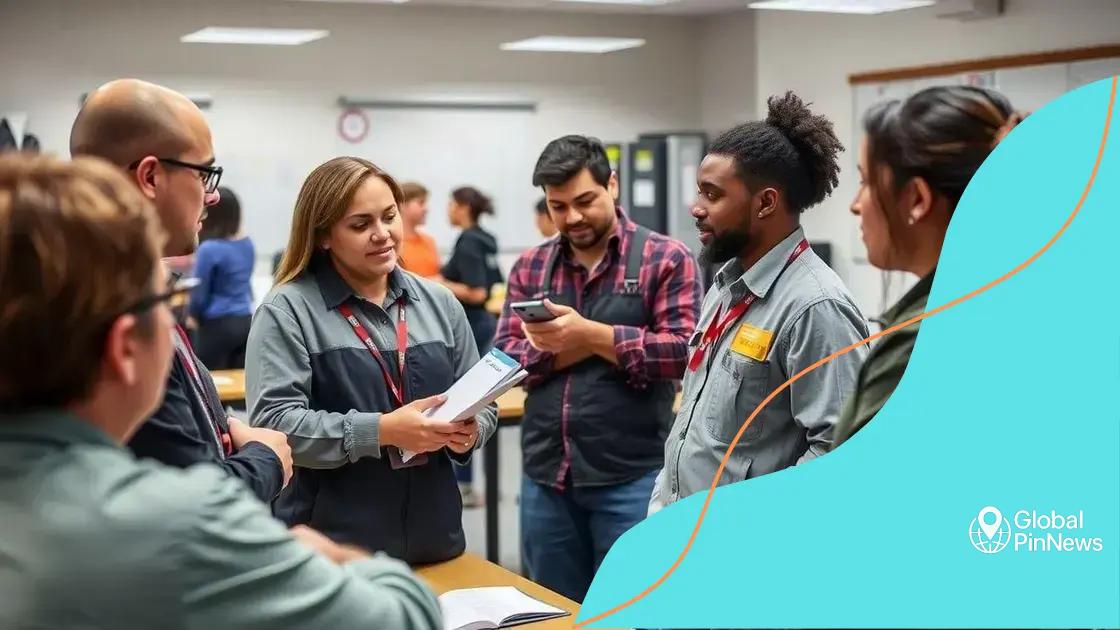Expansion of vocational training access enhances career growth

The expansion of vocational training access enhances career opportunities by integrating technology, promoting inclusivity, and fostering industry partnerships that align skills with job market demands.
Expansion of vocational training access is vital for enabling individuals to gain necessary skills and improve their career prospects. Have you ever wondered how these programs impact communities?
Understanding vocational training
Understanding vocational training is essential for increasing opportunities in today’s job market. These programs provide practical skills that meet the demands of employers, helping individuals enhance their career prospects.
Vocational training is designed to prepare students for specific trades or careers. It focuses on practical experience rather than theoretical learning. This kind of education can take place in various settings, including trade schools, community colleges, and even workplaces.
Benefits of vocational training
By expanding access to vocational training, we unlock numerous benefits for individuals and society.
- Skill Development: Participants gain hands-on experience that equips them with relevant skills for their chosen field.
- Job Readiness: Graduates are often more prepared for the workforce, having gone through real-world scenarios.
- Increased Employment Opportunities: Many employers prefer candidates with vocational training over those with just a high school diploma.
Furthermore, vocational training programs can lead to faster employment as they are specifically tailored to meet local labor market needs. With increased skill levels, graduates often command higher wages and can progress more quickly in their careers.
Types of vocational training programs
There is a wide range of vocational training options available, catering to various interests and industries.
- Apprenticeships: These programs combine on-the-job training with classroom instruction, allowing participants to earn while they learn.
- Certification programs: Many fields, such as healthcare and technology, offer certifications that demonstrate expertise and improve job prospects.
- Short courses: For those looking to quickly change careers or upgrade their skills, short courses offer intensive training.
Overall, vocational training serves as a bridge, connecting education with employment. As more people gain access to these programs, communities see a ripple effect of economic growth and stability, further emphasizing the need for expansion of vocational training access.
Benefits of expanding access to vocational education
Expanding access to vocational education has numerous benefits that contribute to individual growth and community advancement. By providing more opportunities for practical learning, we can help people gain valuable skills needed in the modern job market.
One major benefit of vocational education is that it equips students with hands-on experience that is directly applicable to their careers. Unlike traditional education, vocational programs focus on practical skills that prepare individuals for specific jobs.
Career Advancement
With increased access to vocational programs, individuals can easily improve their job prospects.
- Higher Employment Rates: Graduates of vocational education programs often experience increased job placement rates due to their specialized skills.
- Stronger Job Skills: These programs emphasize skill development, giving students the tools needed to succeed in various trades.
- Opportunities for Advancement: Many employers favor candidates with practical experience, often leading to quicker promotions.
Additionally, vocational education opens doors for individuals who may not thrive in traditional academic settings. Those who learn best through doing can find their niche in careers that interest them without the pressure of passing standardized tests.
Economic Growth
As we broaden access to vocational education, we also stimulate economic growth. When individuals gain skills, they contribute positively to the workforce.
- Meeting Workforce Demands: Companies can fill skill gaps more effectively, ensuring that businesses can operate efficiently.
- Increasing Innovation: A skilled workforce contributes to innovation, as employees can leverage their training to improve processes and products.
- Enhanced Community Stability: Local economies benefit when more people are employed and contributing financially.
Moreover, fostering a culture of vocational education creates accessible pathways for all community members, ensuring equality in career opportunities. As the demand for skilled labor continues to rise, the expansion of vocational education access will be crucial for building a robust economy.
Challenges in providing vocational training to everyone

Despite the many benefits, there are significant challenges in providing vocational training to everyone. Accessibility remains a key issue, as many individuals face barriers that prevent them from participating in programs.
One major challenge is the availability of resources. Many vocational training programs lack sufficient funding, which limits their capacity to offer a wide range of courses. This can lead to a shortage of trained instructors and inadequate facilities, making it difficult for potential students to receive quality education.
Geographical Barriers
Geographical location plays a crucial role in access to vocational education. In rural areas, for instance, available training options may be limited.
- Distance to Training Centers: Many individuals cannot travel long distances to attend classes, which discourages enrollment.
- Lack of Online Options: Some regions do not have access to reliable internet, making online training difficult.
- Underfunded Programs: Without adequate funding, some vocational programs may close, reducing options for local students.
Additionally, there can be a stigma attached to vocational training. Some people may view these programs as less prestigious than traditional academic paths, leading to a lack of interest. Changing perceptions is essential for encouraging more individuals to consider vocational education as a viable option.
Funding and Support
Another significant challenge is securing funding for vocational training programs. When funding is scarce, programs struggle to maintain quality education.
- Government Support: Without adequate support from government agencies, many programs can face cuts that limit their reach.
- Corporate Involvement: Businesses can play a big role in funding training initiatives, but not all companies are willing to invest.
- Awareness Campaigns: There is a need for campaigns that educate the public on the benefits of vocational training to encourage financial support.
By understanding and addressing these challenges, stakeholders can work to expand vocational training access. Initiatives that focus on improving resources and changing perceptions are vital for overcoming the barriers that many face today. The expansion of vocational training access is important, but it requires collaboration and commitment from all sectors.
Successful models of vocational training programs
Successful models of vocational training programs showcase effective ways to equip individuals with the skills they need for specific careers. These models often emphasize hands-on learning, partnerships with local businesses, and community involvement.
One notable example is the apprenticeship model, which blends classroom instruction with real-world experience. In this setup, participants work under experienced professionals who guide them through practical tasks. This method allows learners to apply their knowledge immediately, which enhances retention and understanding.
Key Features of Successful Programs
Effective vocational training programs share several key features that contribute to their success.
- Industry Collaboration: Partnering with local businesses ensures that training aligns with current market needs, better preparing students for employment.
- Customized Curriculum: Tailoring courses to meet the demands of specific industries helps students gain relevant skills that employers seek.
- Mentorship Opportunities: Access to mentors provides students with guidance and support, fostering a strong learning environment.
Additionally, some programs integrate technology into the learning process. Online courses and simulations create dynamic learning experiences. These tools can reach a broader audience and accommodate various learning styles.
Global Examples
Various countries have implemented successful vocational training initiatives that can serve as models for others.
- Germany: The dual education system combines classroom learning with practical training in companies, resulting in high employment rates among graduates.
- Singapore: Focused on continuous skills upgrading, Singapore’s SkillsFuture program offers citizens various training options, aligning their skills with industry needs.
- Canada: The Canadian Apprenticeship Program provides hands-on training while promoting trades, which encourages more young people to enter skilled professions.
These models demonstrate how effective vocational training programs can improve the workforce and drive economic growth. By learning from the successful practices of others, we can enhance our own vocational training initiatives and support the expansion of vocational training access for all individuals.
Future trends in vocational training accessibility
Future trends in vocational training accessibility are continually evolving to meet the needs of today’s workforce. As industries change and technology advances, vocational training programs are adapting to provide better access and more effective learning experiences.
One key trend is the increasing integration of technology in vocational training. Online courses and virtual reality simulations are becoming common. These innovations offer flexible learning options, allowing individuals to gain skills from anywhere, at any time.
Inclusive Learning Environments
Another important trend is the push for inclusivity in vocational training programs. Creating an accessible learning environment is essential for reaching all individuals, regardless of their background.
- Diverse Curriculum: Courses are being designed to cater to various learners, including those with disabilities and different learning styles.
- Community Outreach: Programs are focused on reaching underserved populations through partnership initiatives, ensuring that everyone has access to training.
- Support Services: Many institutions are now offering additional resources such as tutoring, counseling, and mentoring to support students’ success.
Moreover, the demand for soft skills training is rising. Employers are looking for candidates with strong communication, teamwork, and problem-solving abilities. Vocational programs are beginning to incorporate these elements to create well-rounded graduates.
Government and Business Partnerships
Increased collaboration between governments and businesses is shaping the future of vocational training. This partnership helps align training with real-world job requirements, ensuring graduates are job-ready.
- Funding Initiatives: Government programs are providing financial support to vocational training institutions, allowing them to expand and improve.
- Industry-Sponsored Programs: Many companies are offering tailored training programs for specific skill sets required in their fields.
- Feedback Loops: Regular feedback from employers allows educational institutions to refine their curriculum based on industry needs.
These trends indicate a promising future for vocational training accessibility. By embracing innovation and focusing on inclusion, vocational programs can effectively prepare individuals for successful careers, contributing to the overall expansion of vocational training access.
FAQ – Frequently Asked Questions about Vocational Training Access
What are the main benefits of vocational training?
Vocational training provides hands-on experience, improves job readiness, and increases employment opportunities for individuals.
How does technology enhance vocational training?
Technology, such as online courses and virtual reality, enables flexible learning and better engagement, allowing students to acquire skills more effectively.
Why is inclusivity important in vocational training programs?
Inclusivity ensures that all individuals, regardless of background or ability, have access to the training they need to succeed in the workforce.
What role do industry partnerships play in vocational training?
Industry partnerships help align training with job market needs, ensuring that programs equip students with the skills that employers seek.
